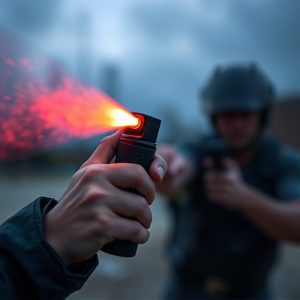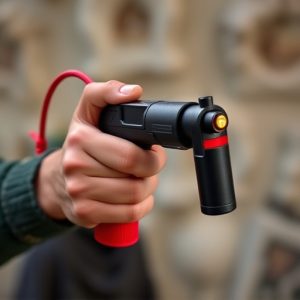Police Grade Pepper Spray: Maintenance, Storage, and Safety Secrets
Pepper spray, a critical tool for law enforcement, relies on proper maintenance and storage for opti…….
Pepper spray, a critical tool for law enforcement, relies on proper maintenance and storage for optimal performance. Key practices include temperature control (50-70°F/10-21°C), shielding from direct sunlight, regular inspections, and replacing expired units. Police-grade pepper spray is designed for durability and precision application, with advanced nozzles and higher capsaicin concentrations. Effective maintenance involves cleaning, testing, secure storage, and preventing damage or leakage. Correct storage conditions, including well-ventilated areas and childproof containers, ensure the spray's potency and prevent accidental discharge, ultimately enhancing police safety during operations.
“Uncover the power of police-grade inflammatory pepper spray compounds—a crucial tool in law enforcement. This comprehensive guide delves into the intricate world of these advanced sprays, exploring their composition, effectiveness, and unique features designed for optimal performance. From understanding the science behind the spray to mastering maintenance and storage practices, we provide essential insights. Learn about safety protocols, proper handling techniques, and secure storage methods to ensure potency and mitigate risks associated with pepper spray maintenance and storage.”
- Understanding Pepper Spray Compound: Composition and Effectiveness
- Police Grade Spray: Features and Advantages for Law Enforcement
- Maintenance Guidelines: Ensuring Optimal Performance and Safety
- Secure Storage Practices: Best Methods to Preserve Potency
- Safety Protocols: Handling, Application, and Post-Use Care
Understanding Pepper Spray Compound: Composition and Effectiveness
Pepper spray, a powerful law enforcement tool, is an inflammatory compound designed to temporarily incapacitate individuals through targeted irritation of the eyes, nose, and respiratory system. The primary active ingredient in most pepper sprays is capsaicin, derived from chili peppers. This compound stimulates nerve endings, causing intense pain, discomfort, and temporary blindness, enabling police officers to subdue suspects safely.
Effective pepper spray maintenance and storage are crucial for optimal performance. Proper storage conditions, including temperature control and protection from direct sunlight, ensure the preservation of the spray’s potency. Regular inspection and timely replacement of used or expired cans are essential parts of pepper spray maintenance routines. Understanding the compound’s composition and implementing suitable storage practices contribute to ensuring the reliability and safety of this critical law enforcement tool.
Police Grade Spray: Features and Advantages for Law Enforcement
Police-grade pepper spray is designed with robust features and advantages tailored to meet the demanding needs of law enforcement officers in various high-risk scenarios. Unlike civilian-use sprays, these specialized compounds are engineered for maximum effectiveness, durability, and reliability under extreme conditions. They often contain higher concentrations of capsaicin, the active ingredient responsible for the burning sensation associated with pepper spray, ensuring swift and potent incapacitation.
Additional features such as advanced nozzles for precise application, resistance to wind and weather conditions, and quick-release mechanisms enable officers to deploy the spray effectively while minimizing collateral damage. Moreover, proper Pepper Spray Maintenance and Storage is crucial to ensure its longevity and readiness when needed. Law enforcement agencies must adhere to strict protocols for regular cleaning, testing, and secure storage to guarantee optimal performance, safety, and accountability.
Maintenance Guidelines: Ensuring Optimal Performance and Safety
Proper pepper spray maintenance and storage are crucial for ensuring optimal performance and safety. It’s important to keep the container tightly closed when not in use, storing it in a cool, dry place away from direct sunlight or extreme temperatures. Regularly inspect the spray for any signs of damage or leakage, discarding it if any issues are found.
Follow manufacturer guidelines for cleaning and replacing the spray mechanism. Store pepper spray out of reach of children and pets, and never leave it unattended in public areas. In terms of longevity, proper care can extend the lifespan of your pepper spray, ensuring you’re prepared when facing potential threats.
Secure Storage Practices: Best Methods to Preserve Potency
Proper storage is paramount for maintaining pepper spray potency and effectiveness. Law enforcement agencies must implement secure storage practices to safeguard their supplies, ensuring they remain ready for deployment when needed. One of the primary considerations is temperature control; extreme heat or cold can degrade the chemical composition of pepper spray over time, reducing its potency. Ideal storage conditions typically involve maintaining a consistent temperature between 50-70°F (10-21°C) and relative humidity levels around 40-60%. This can be achieved through dedicated storage facilities equipped with climate control systems.
Additionally, pepper spray should be stored in secure containers designed to prevent unauthorized access and accidental discharge. These containers should be made of durable materials, sealed tightly, and equipped with childproof locking mechanisms. Well-ventilated areas are also essential to avoid the buildup of volatile gases that could compromise the integrity of the spray. Regular inventory checks and rotation of stock ensure that pepper spray remains at its peak performance, ready for use when required by law enforcement personnel.
Safety Protocols: Handling, Application, and Post-Use Care
When handling police-grade inflammatory pepper spray, safety protocols must be strictly adhered to. This includes proper storage and maintenance to ensure its effectiveness and prevent accidental discharge or contamination. Pepper spray should be stored in a cool, dry place, away from direct sunlight and heat sources, to preserve its potency. It is crucial to keep the containers sealed and out of reach of unauthorized personnel for security reasons.
Application of pepper spray requires training and caution. Officers should be familiar with the spray’s range, wind conditions, and proper technique to maximize effectiveness while minimizing harm to bystanders. After use, thorough cleaning and decontamination are essential. This involves washing affected areas, disposing of contaminated clothing, and following department protocols for equipment maintenance and storage to prevent cross-contaminating other batches or instruments.
Pepper spray is a powerful tool for law enforcement, but its effectiveness relies on proper maintenance and storage. By understanding the composition and safety protocols outlined in this article, including secure storage practices and regular upkeep, officers can ensure optimal performance when it matters most. Implementing these guidelines will not only preserve the potency of pepper spray compounds but also enhance officer safety and operational efficiency. Remember, proper Pepper Spray Maintenance and Storage are key to maximizing its potential as a critical tool in law enforcement.


